The Brazos Review: AMD's E-350 Supplants ION for mini-ITX
by Anand Lal Shimpi on January 27, 2011 6:08 PM ESTHeavy Lifting: Performance in Complex Workloads
Brazos is clearly faster than Atom in light workloads, but what about in more complex/heavier applications? Are the Bobcat cores enough to allow E-350 systems to move up in the world or will they still be confined to the web browsing/email usage models of netbooks? I've run the E-350 through our entire Bench suite to find out. If you want the full gamut of results head over to CPU Bench, but I've chosen a few here. I also included performance results from a 2.66GHz Pentium 4 to put things in perspective for users of really old systems.
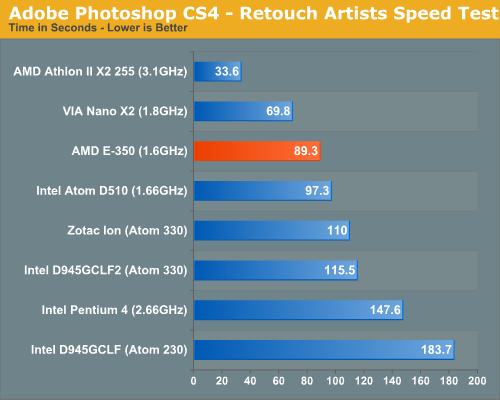
Photoshop CS4 performance is not half bad on the E-350 compared to other similarly priced platforms. Also impressive is the E-350's performance advantage over the old Pentium 4. Compared to the Athlon II X2 however the E-350 is still noticeably slower.
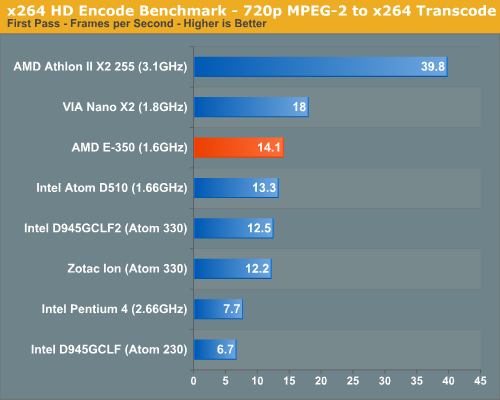
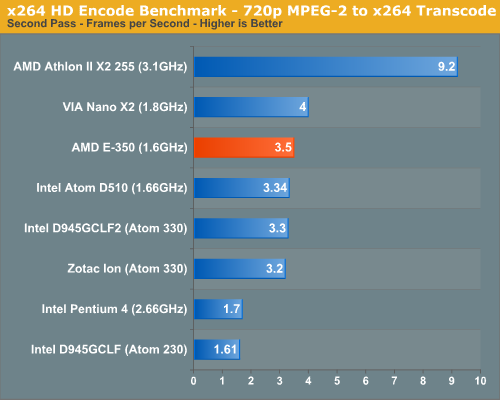
The standings and performance trends continue in our x264 encode benchmark. I don't expect you to do a lot of video transcoding on the E-350 as it's not much faster than Atom here. VIA's dual-core Nano is a bit quicker but still not enough to make this a viable usage case.
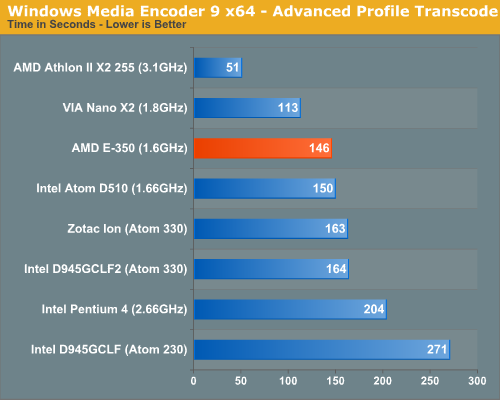
Windows Media Encoder provides a far lighter workload, but the standings don't change. The E-350 is faster than anything Atom based, faster than the old Pentium 4, but slower than VIA's Nano X2.
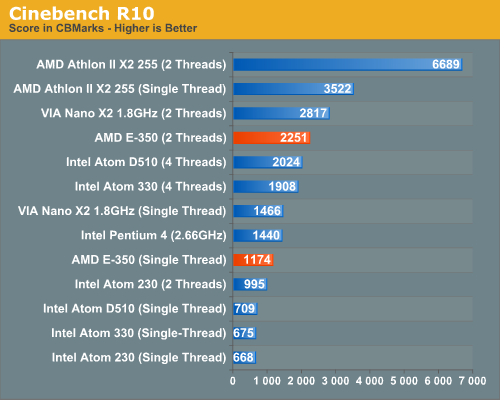
While I don't expect E-350 users to do any offline 3D rendering work, Cinebench does give us a good characterization of single threaded performance. The problem with Atom is that its single threaded performance isn't nearly as good as its multithreaded performance. In all of the previous benchmarks an Atom D510 is clearly quicker than the old 2.66GHz Pentium 4, but looking at single threaded Cinebench R10 you get a different story entirely. The P4 has nearly twice the single threaded performance of an Atom D510.
The E-350 is still a bit behind the Pentium 4 in single threaded performance, but it's not nearly as bad as Atom. The out-of-order execution engine helps tremendously here. What you get as a result is a system that doesn't really feel slower than a 5 year old PC but has the features of a more modern system.
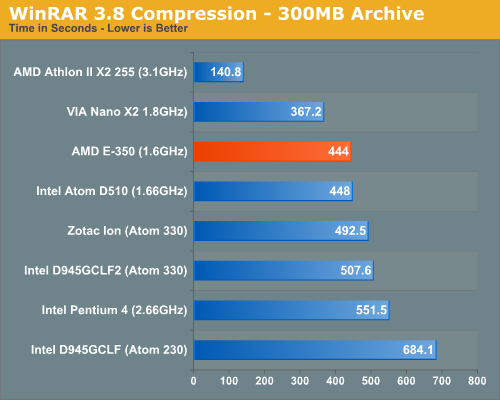
Overall the E-350 is clearly faster than Atom ever was at running these heavier workloads. The highly threaded workloads aren't much faster on E-350 vs. Atom thanks to the latter's Hyper Threading , but single threaded performance continues to play an important role and is a huge advantage of AMD's. VIA's simple out-of-order architecture is consistently faster than the E-350, however I don't expect to see widespread adoption or support for VIA's platform (at least compared to AMD's). Compared to the larger out-of-order x86 cores the E-350 is still in a lower performance class, the Athlon II X2 is easily twice as fast as the E-350 in these tests.
Ultimately the same rules that applied to Atom based systems apply to Brazos systems:
1) Swapping to disk is painful so you need enough memory (I'd recommend no less than 2GB for Windows 7, ideally 4GB) and you'll want a fast HDD. My preference is still an SSD, even a low end value drive over even a fast hard drive. Even a low end SSD (e.g. Kingston SSDNow V100) will make a Brazos system feel acceptably fast.
2) Outside of media playback and some gaming, you're still limited in the types of applications and workloads you can run on Brazos. The Brazos platform is great for web browsing/email workloads, but don't try to do too much more with it. The advantage over Atom here is that Brazos just does those things noticeably faster.










176 Comments
View All Comments
tno - Thursday, January 27, 2011 - link
http://www.anandtech.com/show/4017/vias-dual-core-...Not a full review but darn close.
e36Jeff - Thursday, January 27, 2011 - link
they did, its here:http://www.anandtech.com/show/4017/vias-dual-core-...
Problem is that what they tested was basically an engineering sample built on the wrong node, they havent gotten anything to market yet, so actual numbers from real products are unknown. having said that, yeah it does look like it might be better, but until someone makes a product based on it, we'll never know.
nitrousoxide - Thursday, January 27, 2011 - link
The price itself is stopping Nano X2 from dominating APU or Atom in the compete. The Nano platform consists of 3 different chips (aka CPU, NB, SB as the traditional layout) but the latter two managed to do that with only one chip, especially APU with very small die size. While Nano X2 is an impressive part compared to APU and Atom in absolute performance, it's not competitive in other features such as die size, price and power consumption.Tralalak - Friday, January 28, 2011 - link
AMD Zacate TDP Configs@18W + Hudson M1 = Fusion Controller Hub = ("South Bridge") TDP Configs@2,7W to 4,7 W for typical configurations === AMD Brazos 20,7W to 22,7W TDP. (2 chip solution)VIA say: VIA Nano X2 have some TDP than VIA Nano Single-Core.
VIA Nano X2 1.4GHz (40nm TSMC) have some TDP than VIA Nano U3200 1.4GHz (65nm Fujitsu) TDP = 6.5W
VIA Nano X2 1.4GHz max. TDP@6.5W + all-in-one chipset VIA VX900 MSP (Media System Processor = North Bridge (IGP) + South Bridge) max. TDP@4,5W === max.TDP@11W (2 chip solution)
I mean that In "minibotebook market" is very competitive.
VIA's 40nm next all-in-one chipset VIA VX MSP with DirectX 11 IGP refresh will appear in Q4 2011.
mczak - Monday, January 31, 2011 - link
VX900 has Chrome9 HC3 graphics core at 250Mhz - the same as VX800. Its 3d performance can barely keep up with the atoms anemic IGP (I could not find ANY review of VX900, just VX800), so totally no match for Brazos (though, in contrast to atom, it should support video decode much better). So your TDP comparison basically ignores the 3d part of it (surely the graphics core won't consume that much given its performance).Alright, even if I were to believe the DC Nano has same TDP as the current single core one, traditionally perf/power has never been that good with those VIA chips (not terrible, just not really good). Maybe their TDP definition is different (btw I've never seen a published TDP figure for any of the nano u3xxx series, which you seem to use as reference), also keep in mind runtime of notebooks is barely affected by TDP, much more important if you can get low idle power figures. I have no idea how the VIA platform would compete there (granted the publish idle power of the nano u3xxx cpus is only 100mW), but based on past designs I have to assume not very well (fwiw, this article here doesn't help for that neither, since the atoms don't have all of their mobile siblings power management features enabled).
So, unless VIA delivers, I remain sceptical if they can be competitive. Yes, a 1.4Ghz Nano DC should be quite competitive with 1.6Ghz Zacate performance wise - maybe also power wise, but 3d graphics will be very very sub par. To catch up in that area the new IGP is needed which as you mentioned is q4 (if the graphic core is like VN1000, it should do quite well, though I'll note that VN1000 plus the required southbridge has a 12W TDP).
bjacobson - Saturday, January 29, 2011 - link
I for one will be clicking any links with more info on these nanos! That sorely beat the Brazos out of nowhere hah!I doubt the it'll be much good at games though, and the drivers will be rough.,,
silverblue - Monday, January 31, 2011 - link
I've seen the Nano in comparison with Brazos before so I knew it was capable of being faster, however it'll take a load more power.The last time I saw a proper Nano rundown, we were talking a 65nm chip...
Iketh - Thursday, January 27, 2011 - link
power consumption is considerably higher on NanoAmdInside - Thursday, January 27, 2011 - link
Just curious if it was a fad or are people still buying Atom systems? I bought an Atom netbook but sold it within 30 days cause I couldn't stand it (Dell Mini 10v). Then I bought an ION Zotac Atom 330 system to use as a video streaming device for my bedroom and while I do like it for what it does, I just can't see myself buying another cheap lower powered Atom/AMD E-350 like device. I bought mine because the price made it seem like a great deal but once I got past that, I just lost interest in netbook/low powered mini-ITX platforms. Tablets on the other hand I am still hooked on. Love my iPad and may pick up a second this year and pass mine onto my wife.nitrousoxide - Thursday, January 27, 2011 - link
What APU/Atom can do is still far beyond ARM-based tablet's reach. Just look at how much superiority x86 have in absolute performance. E-350 has roughly 5 times the performance of Tegra 2, and even an Atom is significantly faster. So tablet is just an alternative of nettops, not a replacement. If you are fine with you iPad that's cool, but saying that nettop is dead is still far too early.The superiority of x86 is just unmatched by ARM, and that's why Intel claims that ARM is not a big deal for it. Want to be as fast? Then add more instructions sets, design more complicated architectures, and what you get is no longer an ARM.